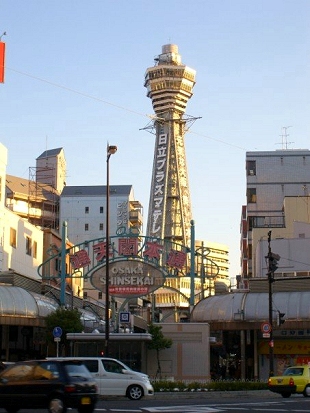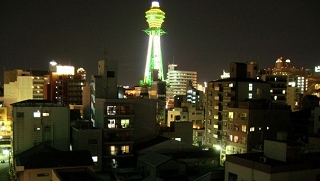Archive
Tsutenkaku and the New World
 I must have been a stronger person when I came to live in Osaka for the first time. Newly divorced, friendless, jobless, and without orientation in my new environment, I would spend two months watching the numbers in my bank book grow progressively smaller as job interviews came and went uneventfully. I gradually compromised my standards until I was desperate enough to apply for any job that looked remotely bearable. The tiny apartment was barren, with only a floor mattress to sleep on, a folding “floor chair” whose protruding metal bars made the hardwood floor feel merciful, and a cart for the television set scuffed-up Playstation 2. To retain my sanity and sustain myself, I bought cheap sake, Meiji chocolate and instant yakisoba from Super Tamade, the obnoxiously bright supermarket with blaring theme music, cashiers who only spoke Chinese, and suspiciously low prices.
I must have been a stronger person when I came to live in Osaka for the first time. Newly divorced, friendless, jobless, and without orientation in my new environment, I would spend two months watching the numbers in my bank book grow progressively smaller as job interviews came and went uneventfully. I gradually compromised my standards until I was desperate enough to apply for any job that looked remotely bearable. The tiny apartment was barren, with only a floor mattress to sleep on, a folding “floor chair” whose protruding metal bars made the hardwood floor feel merciful, and a cart for the television set scuffed-up Playstation 2. To retain my sanity and sustain myself, I bought cheap sake, Meiji chocolate and instant yakisoba from Super Tamade, the obnoxiously bright supermarket with blaring theme music, cashiers who only spoke Chinese, and suspiciously low prices.
The studio apartment was a seven-minute walk from Shin-Imamiya Station, located in what seems to be the largest agglomeration of homeless people in Osaka. Also nearby was the covered arcades of Shin-Sekai and Den Den Town, where smelly old men wandered the streets or simply slept on them, day or night. The neighborhood I lived in was Ebisucho, and my apartment building Rapanjiiru Ebisu III—Rapanjiiru is “Rapunzel” in Japanese. When I was first introduced to the apartment, it was through an agency that catered specifically in to foreign customers, because even today many apartments will reject non-Japanese.
After looking at a series of rancid, decrepit rooms, living in a cardboard box in Osaka Castle Park was starting to look attractive—until we reached that seventh-storey room in Rapunzel Ebisu III. It was clean, conveniently located near the subway station, and close to the city center. I made up my mind when I first stepped out on the balcony and saw a somewhat dingy, yet oddly familiar, metal tower.
“Um, this isn’t…”
“Tsutenkaku? Yeah,” said the agent, laughing derisively at the aging urban landmark.
Then it came back to me: my university professor, who specialized in Osakan history, had mentioned this tower. “So that over there is Shin-Sekai?”
The agent looked surprised. “Yeah! How did you know that?”
But could this really be the Shin-Sekai I had learned about? Was this the fashionable entertainment district of Taisho-period Osaka? Impossible. But there it was, in plain sight: Shin-Sekai, with the landmark Tsutenkaku tower right smack in the center.
 In the early modern period, as Japan rapidly “modernized” to try to gain equal footing, politically and otherwise, with Europe and the United States, planners developed Shin-Sekai (which means “new world”). The area was half modeled after New York City, and half after Paris, with the Eiffel-Tower-inspired Tsutenkaku (the name means “tower reaching the heavens”) as the centerpiece. There was an immensely popular amusement park, Luna Park, located there from 1912 until its closing in 1923. Tsutenkaku was connected to Luna Park by aerial cable car, another modern marvel at the time, and ching-ching of streetcars could be heard from the nearby boulevards. The neon nights, clattering of wooden-shoed feet and giggling of youthful kimono-clad women in Shin-Sekai continued day and night. The brilliant glow of Tsutenkaku could be seen from anywhere in a metropolis that was not yet dominated by high-rise buildings. Shin-Sekai was, to Osakans of the time, truly a marvelous new world.
In the early modern period, as Japan rapidly “modernized” to try to gain equal footing, politically and otherwise, with Europe and the United States, planners developed Shin-Sekai (which means “new world”). The area was half modeled after New York City, and half after Paris, with the Eiffel-Tower-inspired Tsutenkaku (the name means “tower reaching the heavens”) as the centerpiece. There was an immensely popular amusement park, Luna Park, located there from 1912 until its closing in 1923. Tsutenkaku was connected to Luna Park by aerial cable car, another modern marvel at the time, and ching-ching of streetcars could be heard from the nearby boulevards. The neon nights, clattering of wooden-shoed feet and giggling of youthful kimono-clad women in Shin-Sekai continued day and night. The brilliant glow of Tsutenkaku could be seen from anywhere in a metropolis that was not yet dominated by high-rise buildings. Shin-Sekai was, to Osakans of the time, truly a marvelous new world.
After the war, however, when most of Osaka had been burnt clean to the ground and the original Tsutenkaku heartlessly dismantled for parts in desperate support of the war effort, Shin-Sekai had seen its final days as Osaka’s glamorous entertainment district. Almost no effort was put into redeveloping the area in the postwar period, and it diminished into a run-down residential neighborhood. Yakuza gangsters operated in the area until the 1990s, giving Shin-Sekai a reputation as being dangerous that still lingers to this day, and after the Yakuza left, the homeless moved in to occupy the space, which did nothing to improve its image. A faint smell of piss mixed with rotting garbage had come to permeate the air of this former playground for the young.
But all was not lost. Surviving citizens of the neighborhood had not forgotten the glamour of the former Shin-Sekai, and even though the district was physically not what it used to be, the pride and culture of the area remained unscathed. Thanks largely to the efforts of neighborhood donations and volunteers, Tsutenkaku was rebuilt in 1956 in a slightly altered form from the original tower, and began to draw attention as a tourist attraction. Hitachi began sponsoring the tower in 1957—and still does today—dressing it with neon lights that the company renews periodically. This resulted in Tsutenkaku becoming a beautiful thing to see at night, in contrast to the dull, metallic spectacle it provided during the day. The tower was not only a piece of local history; it had become a beacon of hope for wartime recovery. It was also an encouraging companion for this lost American who, alone on his floor mat in Rapunzel Ebisu III, looked out at the shining monolith in the dark and felt a faint stirring in his heart.
 I imagine the way I felt looking out at the tower every night from my window was the same way many local residents must have felt when the tower’s reconstruction was finished and it once again soared in the sky. Through all the good times and all the tribulations, this simple, elegant tower waited for my return home every evening. Even during that first lonely Christmas full of regret and uncertainty, lying next to the cheap plastic tree from the hundred-yen shop, the warm rays of Tsutenkaku softly stealing through the windowpanes provided some semblance of comfort. Shin-Sekai may be a thing of the past, but its spirit, and the spirit of the Osakans who loved it, live on in this tower to the heavens.
I imagine the way I felt looking out at the tower every night from my window was the same way many local residents must have felt when the tower’s reconstruction was finished and it once again soared in the sky. Through all the good times and all the tribulations, this simple, elegant tower waited for my return home every evening. Even during that first lonely Christmas full of regret and uncertainty, lying next to the cheap plastic tree from the hundred-yen shop, the warm rays of Tsutenkaku softly stealing through the windowpanes provided some semblance of comfort. Shin-Sekai may be a thing of the past, but its spirit, and the spirit of the Osakans who loved it, live on in this tower to the heavens.
My Publications
Buy it now on Amazon.com, Amazon.co.uk, Amazon.de, Amazon.fr, Amazon.it, Amazon.es, or through my online store in Japan!.
Osaka Insider: A Travel Guide for Osaka Prefecture
Buy it now on Amazon.com, Amazon.co.uk, Amazon.de, Amazon.fr, Amazon.it, Amazon.es, or through my or through my online store in Japan!.
The Kindle edition is also available in Japan, the United States and many other countries!
My Other Websites
Categories
- A Journey Around Lake Biwa (3)
- Around Osaka (6)
- Bars (8)
- Books (5)
- Gourmet (15)
- History (8)
- My Opinons (6)
- Seasonal/Festivals (9)
- Shopping (2)
- Sightseeing Spots (12)
- Stories (1)
- Uncategorized (16)
- Unique (7)
- Urban Development (2)
| S | M | T | W | T | F | S |
|---|---|---|---|---|---|---|
| 1 | 2 | 3 | 4 | 5 | 6 | |
| 7 | 8 | 9 | 10 | 11 | 12 | 13 |
| 14 | 15 | 16 | 17 | 18 | 19 | 20 |
| 21 | 22 | 23 | 24 | 25 | 26 | 27 |
| 28 | 29 | 30 | ||||
Archives
Blogroll
- Alex Part Deux
- an englishman in osaka
- Chris Backe – AKA Chris in South Korea
- Counting Sheep
- Dreaming in Kanji
- Eye on East Asia
- Food from Fukuoka, Kyushu and Japan
- Friends In Ramen
- From the Islands of Japan to an Island in the Chesapeake
- Fukuoka Sake Guide
- Gaijin Tonic
- Hello, my name is Apple
- How To Be Heian Japanese
- Japanese Blogs
- JapanNewbie
- John Turningpin's Mad Tokyo
- Jonathan Fleming's Blog
- Keeping Pace in Japan
- More glimpses of unfamiliar Japan
- Mottekaero jDonuts
- Nathan Chung: Photography, Video, and Web Programming
- Out Of The Loop Line
- Sushicam
- The Winston Salem Report
- WordPress.com
- WordPress.org
Recent Comments